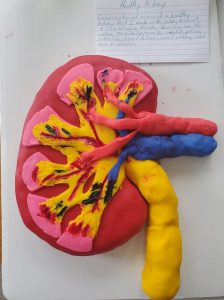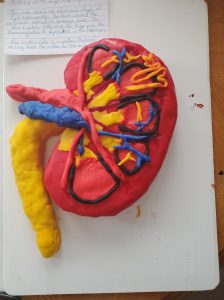Healthy Kidney- Cross-sectional view of a healthy kidney that I made with cake, fondant, and rice krispie treats. You can see the cortex, medulla (pyramids, canals), pelvis, arterioles, renal hilum, renal artery, renal vein and ureter.

Kidney with IgA Nephropathy-This cake shows an advanced stage of IgA Nephropathy. The black around the pyramids represent damage done. The blue and yellow little stick like things are the immunoglobins (IgA) deposited in the kidney. Also on this cake is a yellow Nephron moving from the cortex to the medulla. This Nephrons are what are initially affected by IgA buildup.



Vanessa Ledford explained the kidney’s functions and the way IgA nephropathy impairs the kidney’s ability to function normally. She also discussed some of the physiological effects it can have on our body. She began by making sure we understood the function of our kidneys. I found it interesting to read about how she explained what made the kidneys perfect to perform its essential duties. After explaining the correct passage of the 180 quarts of fluid through the kidney, she went on to explain what happens wrong when the IgA antibody goes awry and build up in the filtration system inside the kidneys. She explained that people would often be asymptomatic for years with this condition then have it appear after an illness. She explained a small sample of how the IgA Nephropathy affects the kidneys and thereby the rest of the body. Sadly, she shared that there is no cure for this disease, so prevention is the best. She also included different treatment options as well as symptoms of kidney disease that you should watch for. Finally, she had a call to action to take care of your kidneys, because they take care of you.
She did an excellent job illustrating the kidney in her art project by creating a cake. I saved the images to refer to them as I work through this unit. It was helpful to see through the illustration precisely where the IgA was, as she depicted large clumps of IgA clumped onto the pyramids.